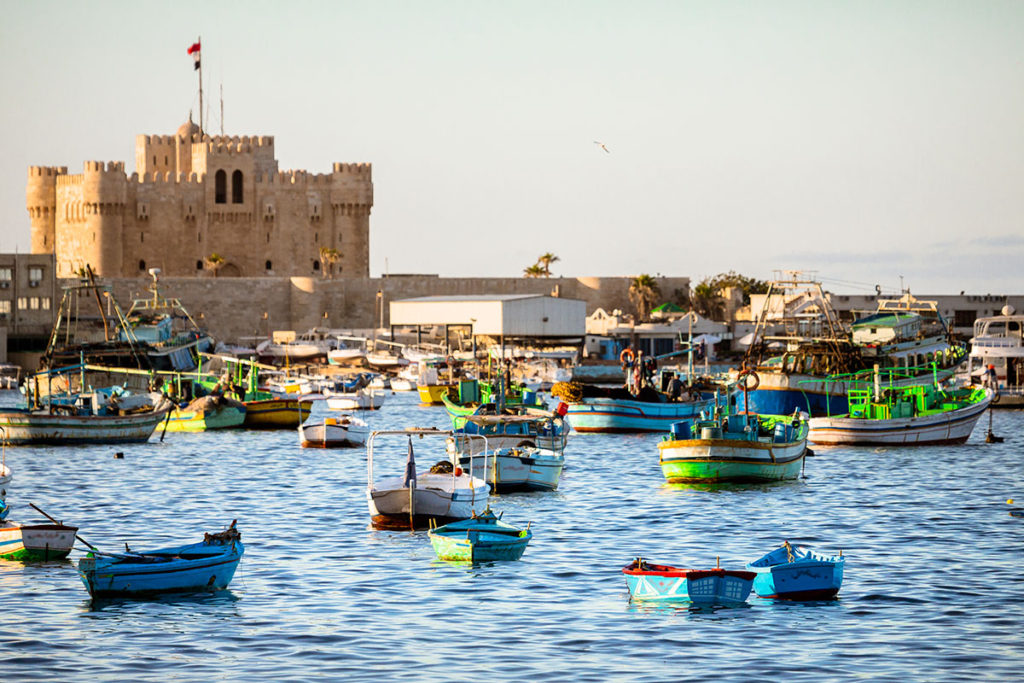By Muhammed Aladdin
A city founded by and named after Alexander the Great, flourished under the reign of Cleopatra and housed the seat of the Patriarch of the Coptic faith. Alexandria, in the Mediterranian azure, remains one of a handful of cities that had such an unperceivable impact on the state of the world.
Despite the modern-styled buildings and the asphalt paving its roads, the ruins of the old city, hide in plain sight to marvel tourists from all four corners of the earth.
Many turn to Cairo, Luxor, or Aswan in the search for the ultimate touristic destination, forgetting the Hellenic legacy of the Pearl of the Mediterranian. So, here is our list of different inspiring archaeological hotspots of ancient Alexandria that make this city wonderful.
Alexandria National Museum

Situated in Fouad Street, the Alexandria National Museum is a guideline to the history of the famed city. The building is filled to the brim with artifacts from different eras including the Pharaonic, Ptolemaic, and Roman. It houses a collection of statues, antiquities, and artworks.
Between exhibitions, there is a number of maps that imagines classical Alexandria, and how it would have looked like if visitors traveled in time.
Qaitbey Castle

At the easternmost end of the corniche, a mighty castle stood guard over Alexandria’s harbor since 1480. In order to protect the northern Egyptian border, The Mamluk Sultan Qaitbey ordered a castle to be built on the ruins of the Pharos Lighthouse, a wonder of the ancient world that got toppled down by a violent earthquake in 1303; its rubble was used in the construction of the fort.
The Roman Amphitheater

Found in Kom Al-Dikka, or “The Mound of Rubbles” in English, was a forgotten ruin until 1947 when excavation efforts discovered remains of an ancient Ptolemaic Temple, a small amphitheater, and the mosaic flooring of a Roman-era house now known as the “Villa of Birds”.
The Catacombs of Kom Al-Shuqqafa

With Catacombs of Egyptian, Greek, and Roman design elements, Kom Al-Shuqqafa is one of the few, well-preserved Roman burial sites in Egypt. Studies found that the stone used in them is hewn from rocks on the Southern slopes of a hill in the Carmous district.
These long-forgotten treasures were discovered in the 1990s when a donkey accidentally fell into them. In more recent years, the tombs have been facing the danger of flooding, and in 2019, it has been announced that the government lowered the catacombs’ level and will inaugurate them as an open museum.
Pompey’s Pillars

In Kom Al-Shuqqafa residential area, rising on the ruins of the ancient temple of Serapis, the red, Aswan-granite column, named after Pompey the Great, stands at a height of 27 meters. The Corinthian-style pillar has nothing to do with Pompey, but in fact, was established to honor Diocletian in 292 A.D. for his efforts in feeding the starving population after the great siege of Alexandria.
Ras Al-Tin Palace

In 1952, the Famed Farouk, the Khedive of Egypt, signed his abdication in Ras Al-Tin Palace and boarded a ship to his exile in Italy. Before the dissolution of the monarchy, the palace was their summer haven when the desert heat of Cairo was too much to bear.
The palace is now open to the public, with a glorious interior and a monumental outer facade that is simply awe-inspiring.
Underwater Alexandria

Ages ago, a substantial section of the city was immersed by the rising sea levels of the Mediterranian. These ruins of Old Alexandria can still be seen today; unlike in the Red Sea, in Alexandria, people do not dive to see colored coral reefs but to see a section of history lost to the eye. There are some Pharaonic statuses that were found during the underwater excavation, a number of Greek artifacts, and the Palace of Cleopatra.
Al-Alamein War Memorials

To the west of Alexandria, lies the city of Al-Alamein, a coastal desert city that once was the ground for the Battle of Al-Alamein, the Allied Forces’ first major victory over Germany during the events of World War II. The town is home to a war museum indicating Egypt’s role in the Second World War and the Commonwealth Cemetery, a tribute to the fallen soldiers of the war.



